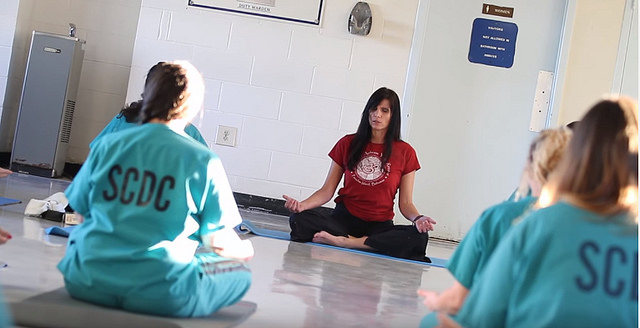Frustration: that was the reason I created my own yoga nonprofit, Karuna Prison Yoga.
For the prior three years, I had been volunteering with a well-known prison yoga nonprofit. The frustration wasn’t directed at the founder of that nonprofit or at myself personally; I simply knew that I needed to expand to better serve the prisoners that I had been teaching.
Up until February of 2017, I had been pulling money from my personal funds to drive long distances to teach yoga in prisons. And while I loved the work, it was beginning to have a slight negative impact on my finances. I also wanted to do more, and doing more often requires funding. Putting all fear and insecurity aside, I took a leap of faith, part of my personal income tax refund, and applied for nonprofit status. Two weeks later, I received notification that Karuna Prison Yoga was a recognized 501(c)3 by the IRS.
And then, I panicked.
I had no idea what I was doing.
But after I stepped back, practiced some ujjayi breathing, followed by a long weekend at the Sivananda Bahamas Ashram, I embraced my newfound challenge and role with fervor.
I was now the founding director and CEO of a yoga nonprofit, and just like anything else in my life, I realized that I could do this. Establishing this organization had been my dream for several years, but now it was coming to fruition. I had no choice but to perform and perform well.
I am by no means an expert on establishing a nonprofit or even running one; in fact, I am still in the novice stage, but I am a firm believer that experience is the best teacher. I am also a firm believer in sharing my experiences regardless of what stage of the game I’m in. Muddling through the process, I’ve learned many lessons that I can share with those considering creating their own yoga nonprofit organization.
Find a unique niche.
In a world where there is a yoga teacher training on seemingly every corner and an influx of yoga teachers, it is imperative to find a population that isn’t currently being served with yoga in one’s corner of the world. If there is already an active yoga nonprofit in one area that serves inmates, for instance, that group may not be a group to focus energy on.
Look around and notice who is not being served and could benefit: homeless shelters, halfway houses, autistic adults, and the elderly in nursing homes are just some of the many groups that could be served with a nonprofit. Opportunities are full in some of the most unlikely and untapped places.
Know something about the population the organization chooses to serve.
It also helps to have experience with the population a person plans on working with and an interest in it. If someone has an aversion to the elderly, then establishing a yoga nonprofit for the elderly may not be the right choice. Before establishing a nonprofit servicing youth, perhaps volunteering with a children’s home or in the local school can help a person decide if working with the group is actually one’s calling. Doing so can save a lot of time and effort in the end.
Taking a training and reading literature specifically directed at that population will aid in preparing the instructor to work with the one at hand; jumping blindly into a situation will not benefit anyone at all, and could even cause more harm than good. In fact, unprepared teachers can be downright dangerous.
Choose a passionate and hardworking board.
A nonprofit is only as strong as its board. Choose individuals who are willing to work hard and focus on the mission statement of the organization. There is no room for wishy-washiness. Like-minded individuals are best because one rotten avocado can taint the entire atmosphere of the group. Avoid cynics, drama queens, control freaks, and anyone else who might try to ruffle the sattva of your organization.
Remember: the focus of a nonprofit is to serve the population set forth in the mission statement. Any person, activity, or behavior that takes away from that focus should be released or avoided altogether. Finding committed board members may take time, and sometimes trial and error is necessary before those individuals emerge. Be patient.
Create an online presence.
Once the nonprofit is established with the IRS, the director should register with entities such as Guidestar, Network for Good, and TechSoup. Doing so only takes a few minutes and will increase the nonprofit’s online presence. Make sure to create an account on all major social media sites and register with Google Business.
Having an online internet presence will help to reach more people, potential donors, and grantors. Once donations begin to flow in, creating a website will also help promote your organization and serve as a platform to show the public what the organization does and who is involved. The more transparent the website, the more it will attract donors, so include as much relevant content as possible.
As the director, be prepared to work.
My yoga nonprofit is my baby. It has taken years and much experience to create it. After hundreds of hours, and maybe even thousands, volunteering and teaching yoga classes in a myriad of settings, my svadharma slowly evolved. This nonprofit is my yoga studio; it may not be a for-profit studio or a brick and mortar one, but it is my mobile studio.
Just like a studio owner wants to protect her studio, a nonprofit director must protect hers and continue to work hard to ensure its continued growth. Research, grant-writing and fundraising, teaching, and social networking will be an ongoing process. Even with a strong board, the director will have her hands in all aspects of the project. A successful nonprofit is built by persevering, even when it may be tempting to give up.
Remember, a nonprofit is a nonprofit.
Yoga nonprofits are based on the principles of karma yoga, one of the four major paths of yoga. The yoga of selfless service, karma yoga is performed without expectation of reward or attachment to outcome.
Directors should not feel guilty if they are unable to pay teachers to teach. Swami Sivananda stated this about karma yoga: “Haft-hearted service is no service at all. Give your whole heart, mind, and soul when you serve. This is very important when you practice Karma Yoga.”
Often our egos creep in, and while we may come across a grant that provides money to pay yoga teachers, most of the time, we should expect to teach without pay. Even rewards such as recognition should not be expectations of karma yoga initiatives. This mindset is hard for any of us to wrap our human brains around, and while we can walk into a karma yoga practice not expecting any rewards, we often receive intrinsic rewards anyway.
Keep detailed records.
Keep detailed records of all transactions. I recommend paying for all expenses with a debit card and keeping receipts to back up the purchases. An electronic trail is also best because if you lose a bank statement, another can be printed at a moment’s notice. In addition, require any teachers to have yoga insurance to protect the organization from liability and make sure all teachers are trained effectively to work with the populations the organization serves. Have their credentials on file.
A nonprofit is still a business and detailed record keeping is a must, especially around tax time. Keep a running list of donors and grantors, and remember to send thank-you notes and tax receipts so that they will be more likely to give again.
Connect with the directors of similar nonprofits and learn from them.
Many times in the past year, I found myself seeking counsel from Anneke Lucas of Liberation Prison Yoga and Mike Huggins of Transformation Prison Yoga. These directors have been around the block and could direct me to information and give advice that would help me to make sound decisions. Doing a Google search to find similar nonprofits can help people make connections if they are at a loss about where to begin. I have found most nonprofit directors are very willing to share their knowledge and experiences.
Don’t be afraid to beg.
Many (well, maybe just a few) are willing to donate products or services in kind to help the organization to get off the ground. Sadly, I have found that most yogis and companies do not donate nor will they even return an email, but some will.
Send out emails explaining the organization’s mission and goals and exactly how their donations will be used to serve and advance them. My organization was lucky enough to receive donations from Jason Crandell, Rolf and Miriam Gates, David Swenson, and a variety of well-known companies, including mats from Jade Yoga. I also include these donors on my website to acknowledge their generosity and show appreciation. Also, giving up is not an option. There are generous yogis in the world, even if sometimes it seems otherwise.
~
Author: Angela Still
Image: Author’s Own
Editor: Catherine Monkman
Copy Editor: Nicole Cameron
Social Editor: Nicole Cameron
 Share on bsky
Share on bsky






Read 19 comments and reply